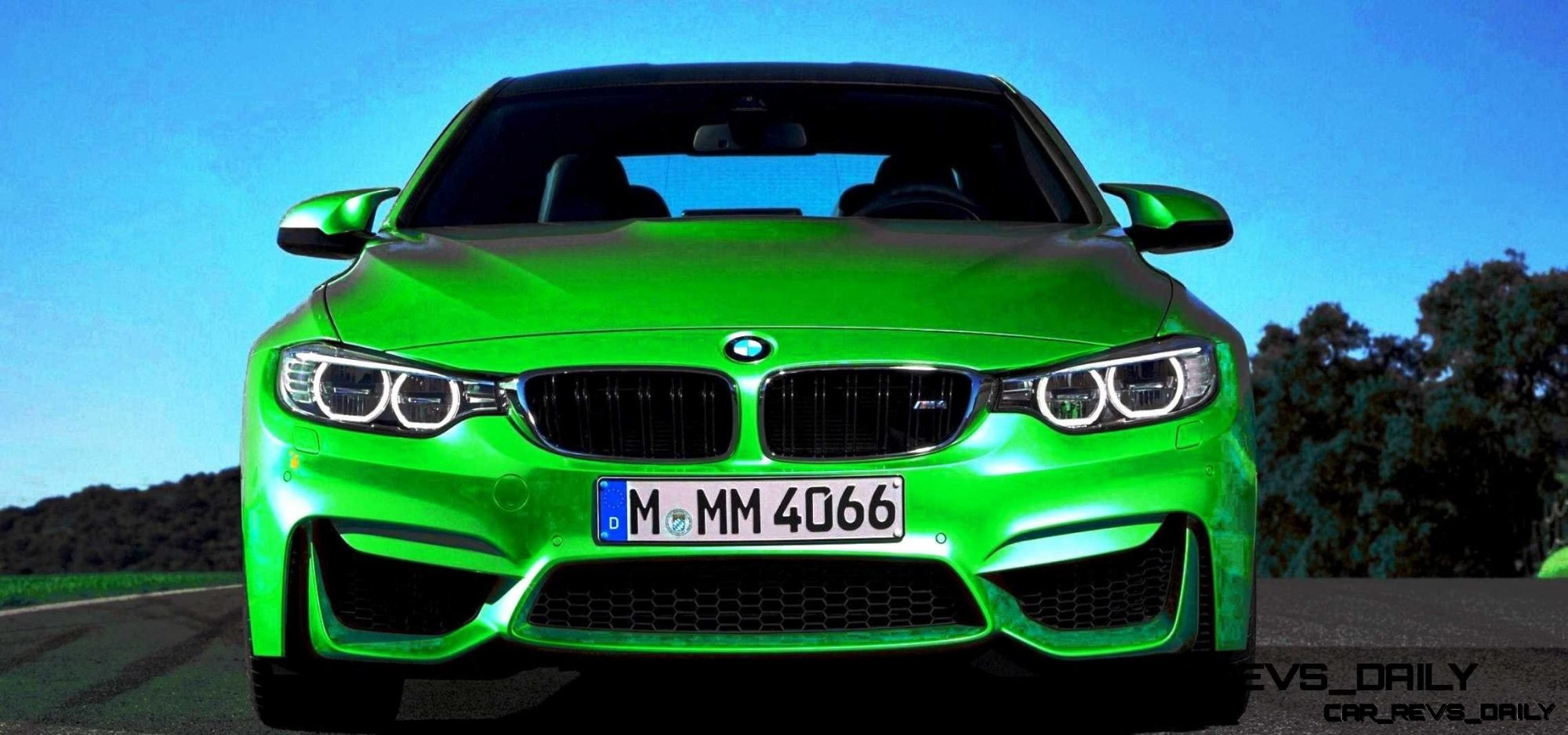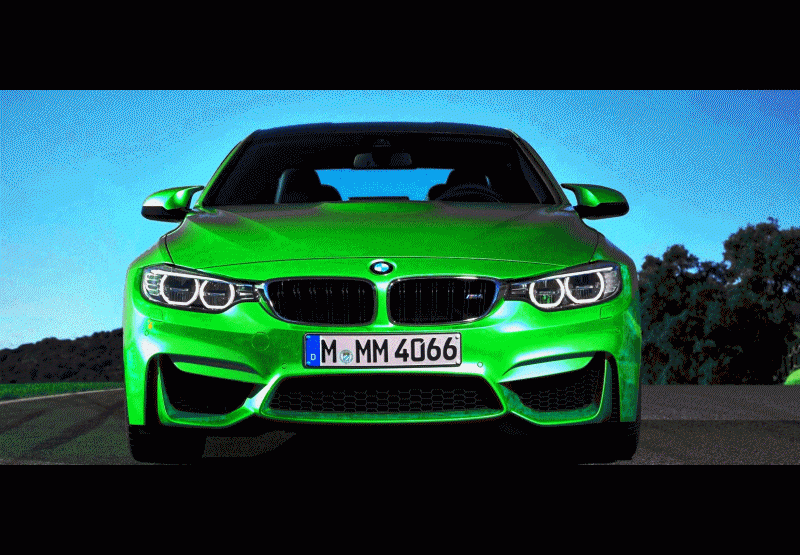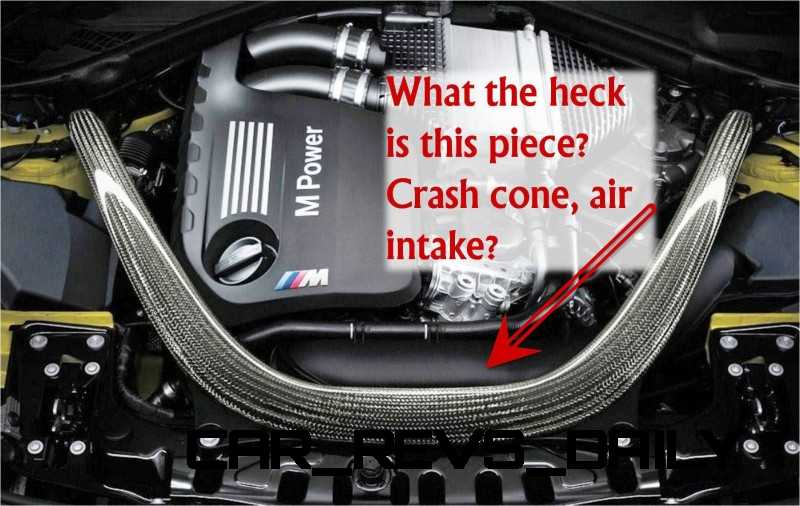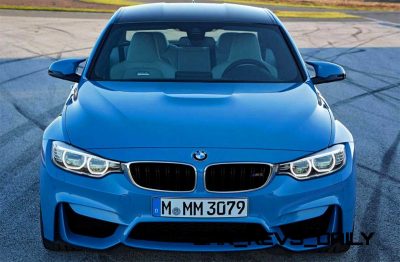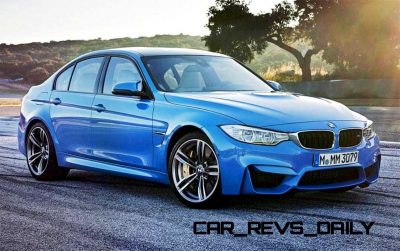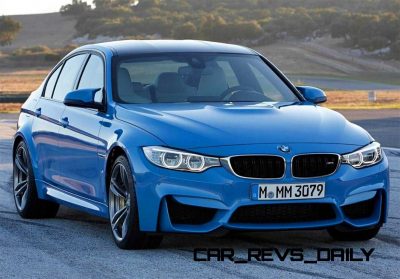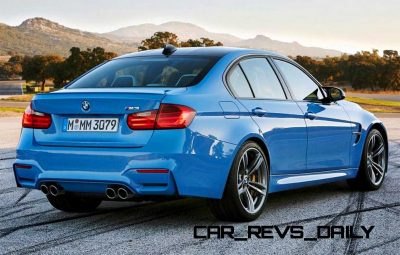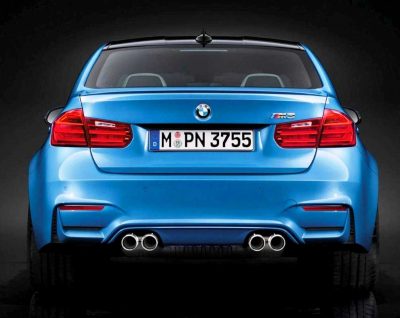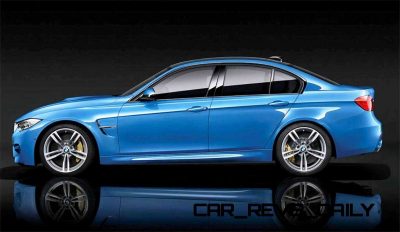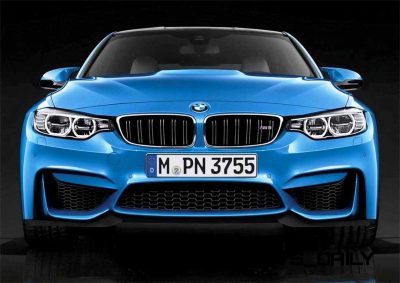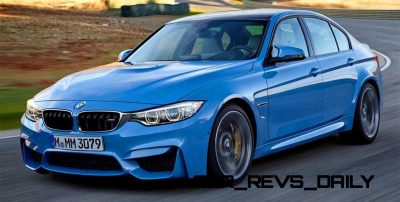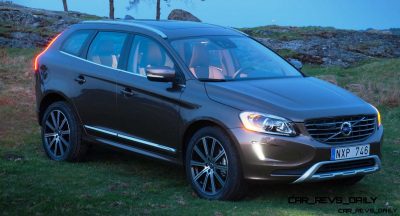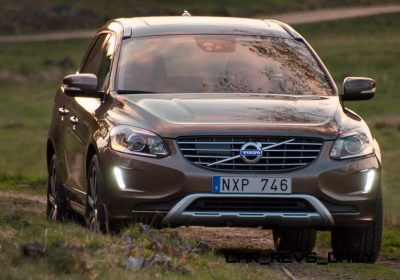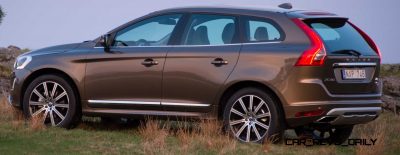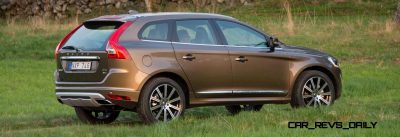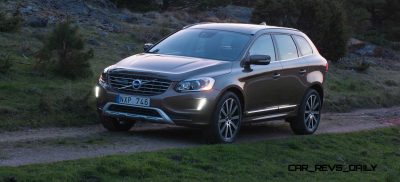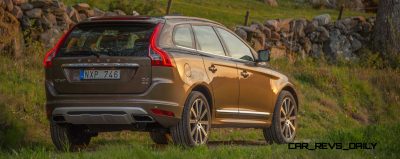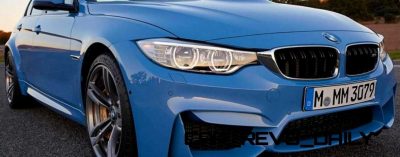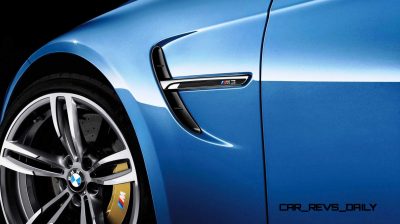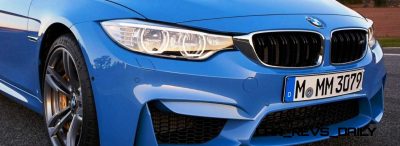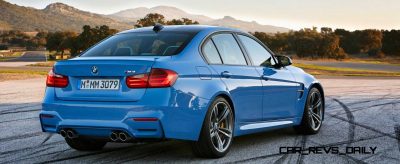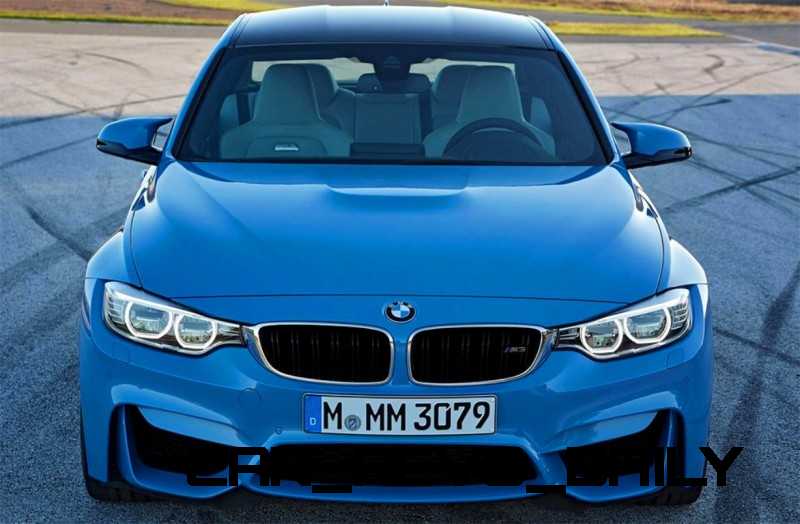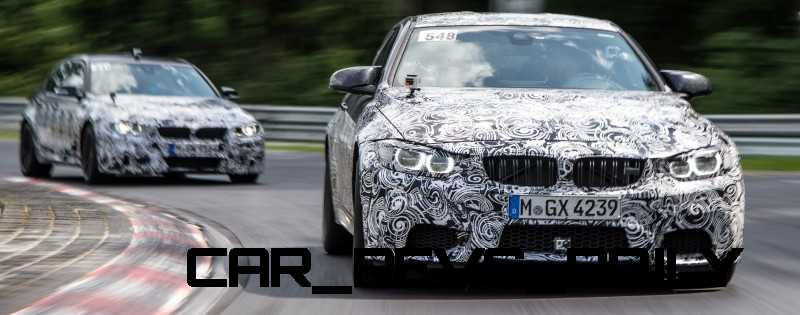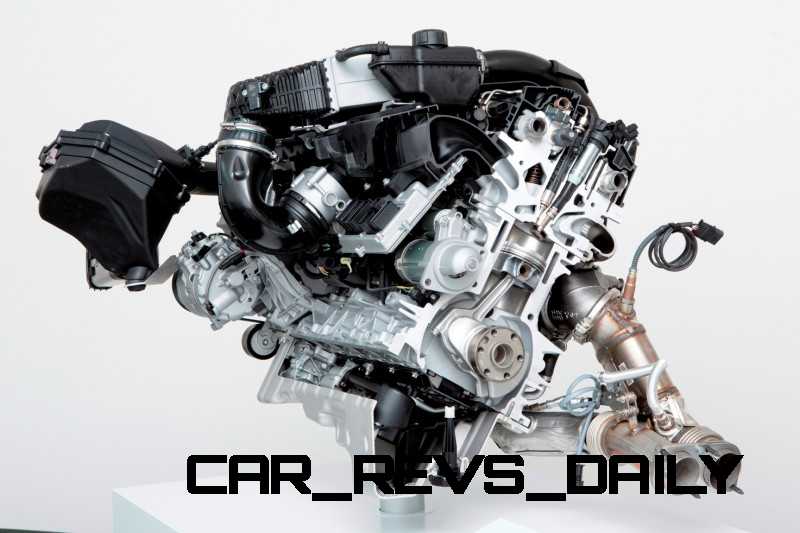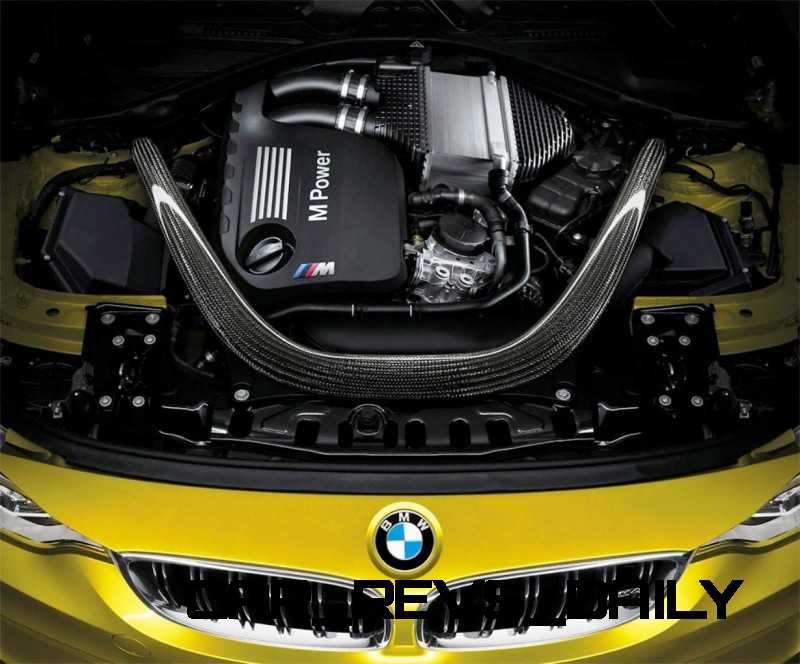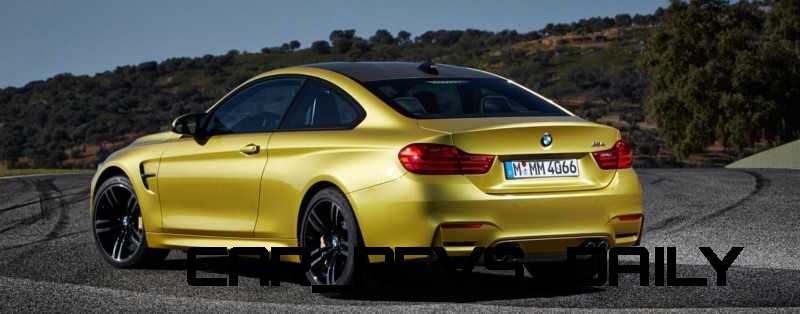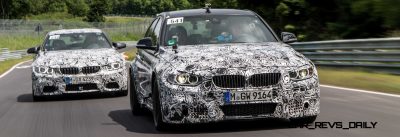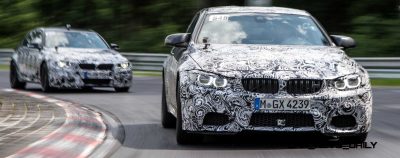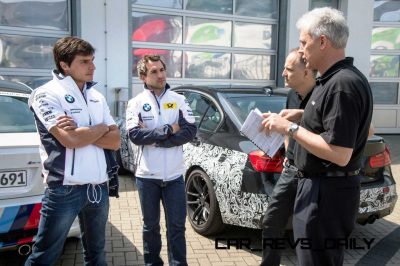What to do in a time like this? One of the most exciting cars of 2014 sneaks onto the web, without BMW’s official blessings.
The best thing we know is to add value to the news, and cite the source. BimmerBoost.com is sure to have its biggest traffic, ever, this week!
WHile the images in all their glory are astounding, there is far more to the M4’s turbocharged howl than just this new yellow paint color.
Yellow?
It is called Austin Yellow Metallic, in case you wondered, and is a dead ringer for the prismatic paint used on the recent Concept M4 show car.
The color continuity helps ensure the M4’s successful launch awareness. There is no escaping this hue: dark at night, lighter than light in the sun.
The styling is absolutely fresh and intoxicating. It passes the “Black and White” test with flying… colors?
Yellow is hard to imagine owning, but some brief experiments show how cool the M4 will look in every shade.
The new M4 is clearly very special outside, but nothing compared with what’s underneath.
The below video and Technical Days info adds some much-needed numbers to the M4.
One question though: what is this carbon-fiber intake/strut brace/crash cone under the hood?
A 2014 model year, its arrival should match the first days of spring 2014 – with orders taken starting this week as well.
Exterior – 2014 BMW M4
Technical – 2014 BMW M4
New M4 Technical Showcase – HD Video
Interior – 2014 BMW M4
BMW M3 and M4 Technology Days.
1. The new BMW M3 Sedan and new BMW M4 Coupe:
Innovative engine technology and a focus on lightweight design.
The launch of the new BMW M3 Sedan and new BMW M4 Coupe sees BMW M GmbH revealing an all-new interpretation of the high-performance sports car – and carrying the BMW M philosophy over into the fifth generation of the M3. More than 40,000 examples of the fourth-generation BMW M3 Coupe were built, and now the BMW M4 Coupe is poised to continue this history of success. The “M4” badge is a reference to the model series that provides the basis for the new M model. And for the first time, the Coupe will be introduced at the same time as the four-door variant, which logic dictates will be christened the BMW M3.
“Four generations of the BMW M3 have blended motor sport genes and uncompromised everyday usability within an emotionally rich overall concept;” explains Dr Friedrich Nitschke, President BMW M GmbH. “The BMW M3 Sedan and BMW M4 Coupe represent an ongoing commitment to this philosophy. The engine is the heart of every M model, and the example fitted in the two new cars combines the virtues of a high-revving naturally aspirated unit with the strengths of turbocharger technology. An all-embracing lightweight design concept keeps the cars’ weight to just under 1,500 kilograms. The BMW M3 and BMW M4 take motor sport technology from the track to the road, and thousands of laps of the legendary Nürburgring Nordschleife – the world’s most demanding race track – have readied the new models for that transition. Meticulous and passion-fuelled development work has underpinned the creation of two high-performance sports cars that set new standards in terms of overall concept, precision and agility.”
The high-revving six-cylinder in-line engine with BMW M TwinPower Turbo technology newly developed for the new BMW M3 Sedan and BMW M4 Coupe produces maximum output of approximately 430 hp. Its peak torque soars far beyond 500 Newton metres (369 lb-ft), outstripping the figures recorded by the outgoing BMW M3 by well over 30 per cent. And yet the engine also achieves a reduction in fuel consumption and emissions of around 25 per cent. The weight of the cars has been reduced to just under 1,500 kilograms, which helps to ensure outstanding driving dynamics and exceptional efficiency.
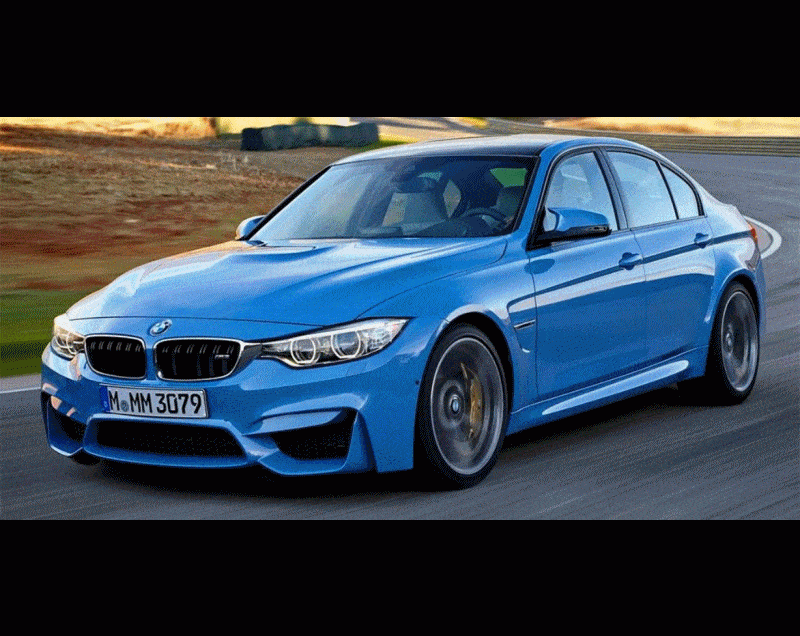
2. The balance of the overall concept:
A blend of elements working in perfect harmony delivers outstanding performance, precision and agility.
The new BMW M3 Sedan and new BMW M4 Coupe share a low-slung and broad-set, yet finely balanced, stance on the road, highlighting the emphasis on performance capability in the emotional development of M design. Large
air intakes at the front end, exposed carbon-fibre-reinforced plastic (CFRP) components and the diffuser at the muscular rear end are far from mere design flourishes; they also fulfil functional roles in terms of aerodynamics, cooling and weight saving.
Numerous aerodynamics measures integrated into all areas of the body.
The aerodynamics concept of BMW M GmbH models has always been one of the key elements in their development. The engineers need to channel the air around the car to create the best possible platform for dynamic excellence, while also ensuring the engine, powertrain and brakes receive the requisite cooling given the significant loads they are operating under. But at the same time, the cars should also have a good Cd – an indicator of impressive efficiency at higher speeds, in particular.
Details such as the powerfully formed front apron, smooth underbody and clearly defined Gurney spoiler lip at the rear of the M3 Sedan (or integrated spoiler lip at the rear of the BMW M4 Coupe) reduce lift by an equal degree at the front and rear axle and produce optimum handling attributes. These examples underline in familiar fashion the success of M engineers in reconciling the requirements of everyday use with the demands of action on the race track. Elements like the Air Curtain and M gills with integrated Air Breather rearwards of the front wheels minimise turbulence in the front wheel arches. And, together with the smoothly sculpted exterior mirrors, they are also highly distinctive design features of the BMW M3 Sedan and BMW M4 Coupe.
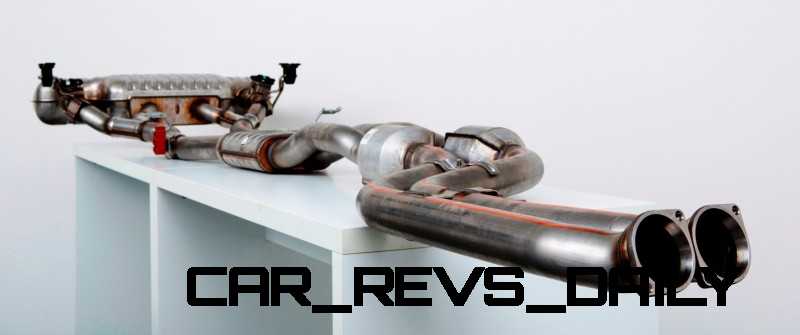
Sophisticated cooling concept for maximum performance.
The exceptional performance potential of the BMW M3 Sedan and BMW M4 Coupe places extremely exacting demands on temperature management in the engine and peripheral assemblies.
In order to ensure optimum operating temperatures in everyday use, on short journeys around town and on the race track, the BMW M GmbH engineers have developed an extremely effective cooling system.
For example, alongside the two ultra-dynamic turbocharger units, the air intake system of the six-cylinder engine also includes an indirect intercooler to cool the intake air, maximising charge pressure and engine output.
As well as a main radiator, the track-ready cooling concept also comprises additional radiators for the high- and low-temperature water circuits, turbocharger and transmission oil.
These ensure a consistent temperature balance and therefore unrestricted performance during hard driving. An additional electric coolant pump cools the turbocharger bearing mounts when the car is stationary.
The powertrain gains from a wide variety of motor sport technologies.
The many years of experience in motor sport clocked up by the BMW M engineers also make their presence felt in the construction of the powertrain for the new BMW M3 Sedan and BMW M4 Coupe. For example, the engine’s impressive torque is sent on its way by a forged crankshaft with high torsional rigidity, whose low weight also allows a significant reduction in rotating mass. The crankshaft therefore helps to optimise the engine’s responsiveness and acceleration and makes an important contribution to its high-revving character.
The engine sends its power to the wheels through a six-speed manual gearbox as standard. This gearbox is significantly more compact than its predecessor and 12 kilograms lighter, allowing it to assist the car’s optimum – virtually 50:50 – weight distribution. As a means of increasing shift comfort, the manual gearbox uses innovative new carbon friction linings in its synchroniser rings. Dry sump lubrication provides an efficient supply of oil to all parts of the gearbox. The new gearbox also works a lot more quietly than before and blips the throttle on downshifts – previously a feature reserved for
the M Double Clutch Transmission. This engagement speed control function helps to enhance stability and was originally developed by motor sport engineers.
Seven-speed M Double Clutch Transmission with Launch Control.
The optional seven-speed M Double Clutch Transmission with DriveLogic takes a very special route to combining the apparently conflicting values of absolute sports performance and comfort. As well as changing gear automatically, in manual mode the transmission enables ultra-fast gear changes with no interruption in the flow of power. The integrated Launch Control function ensures optimum sprinting performance off the line, producing acceleration figures that would be out of range with the manual gearbox. The M Double Clutch Transmission also offers drivers extra functions, such as selectable modes which make the BMW M3 and BMW M4 more comfortable, easier on fuel or even sportier. The extra gear over the manual gearbox allows more tightly spaced ratios – and delivers the positive effects on performance and efficiency you would expect as a result.
The material properties of carbon have allowed the engineers to follow a fundamentally new approach in the manufacture of the drive shaft. This component feeds the engine’s torque from the gearbox to the rear differential and works under extremely heavy loads – especially in high-performance vehicles. The impressive stiffness and low weight of CFRP as a material allow the drive shaft to be constructed as a single-piece unit with no centre bearing. As well as a weight saving of 40 per cent over its predecessor, this leads to a reduction in rotating masses and, in turn, to sharper responses to movements of the accelerator, combined with enhanced dynamics.
Another feature that adds fresh polish to the dynamic repertoire of the BMW M3 Sedan and BMW M4 Coupe is the Active M Differential. Unlike the manual system used by the outgoing BMW M3, here an electric actuator constantly varies the locking effect, as required. That enables better traction, the adjustability of the car is improved, and understeer coming out of corners is dialled out to impressive effect. M Dynamic Mode – a subfunction of the Dynamic Stability Control (DSC) system – quenches the thirst of enthusiastic drivers for keen dynamics. While DSC intervenes as required to counteract understeer and oversteer, M Dynamic Mode allows greater wheel slip and therefore easy drifting. Owners with a taste for sporty and dynamic driving will appreciate this breadth to the cars’ handling, although DSC will still step in if the car ventures over the limits – unless it is switched off completely. Whichever setting the driver chooses, he or she remains responsible for the car’s stability.
Aluminium suspension elements ensure sharper dynamics.
The core expertise of BMW M GmbH resides in creating cars that offer impressive steering precision, on-the-limit adjustability, agility and driving feeling, together with unbeatable traction and outstanding directional stability – all without neglecting everyday usability. In order to blend these attributes with the significantly increased performance capability of the new BMW M3 Sedan and new BMW M4 Coupe, the axles of the outgoing BMW M3 have undergone further development and all relevant components have been newly designed or constructed.
Here again, low weight and a high level of structural rigidity are essential ingredients in ensuring the cars provide an ultra-dynamic driving experience. In the double-joint spring strut front axle alone, the use of a lightweight aluminium construction for components such as control arms, wheel carriers and axle subframes saves five kilograms over a conventional steel design.
Play-free ball joints and elastomer bearings developed specially for the BMW M3 Sedan and BMW M4 Coupe ensure an optimum and direct transfer of forces both laterally and longitudinally. An aluminium stiffening plate, CFRP front strut brace and additional bolted joints between the axle subframe and the body sills all help to increase the rigidity of the front structure.
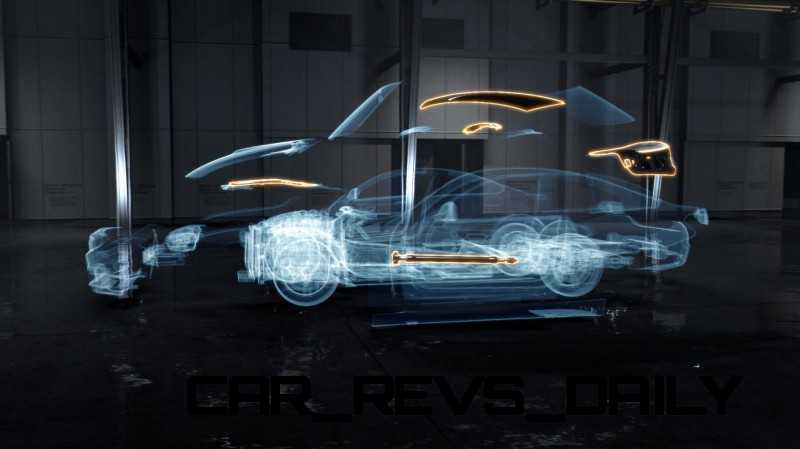
Also lighter than the construction in the outgoing BMW M3 is the new fivelink rear axle. All the control arms and wheel carriers are manufactured using forged aluminium, which reduces the unsprung masses of the wheel-locating components by around three kilograms compared with the previous model generation. The rigid connection between the rear axle subframe and the body – without the use of elastic rubber elements – is borrowed from motor sport and serves to further improve wheel location and therefore directional stability.
The development of the tyres for the cars was incorporated from the outset into the construction process for the axles. For high-performance sports cars like the BMW M3 Sedan and BMW M4 Coupe, in particular, steering feel and precision are the foremost considerations in the development of tyres for the front axle, alongside lateral stability and braking forces. At the rear axle, meanwhile, traction, lateral stability and directional stability take centre stage. For this reason, both cars will leave the factory on low-weight forged wheels with mixed-size tyres. The specially developed forged wheels make a significant contribution to the reduction in the cars’ unsprung masses and, in turn, to the optimisation of dynamic qualities and efficiency.
Electric Power Steering with three settings.
The electromechanical steering system used in the BMW M3 Sedan and BMW M4 Coupe is a new development from BMW M GmbH. It has been tuned specially to assist the cause of dynamic driving and offers the gifts of direct steering feeling and precise feedback.
The integrated Servotronic function electronically adjusts the level of steering assistance according to the car’s speed, providing optimum steering characteristics at all speeds. The steering for the BMW M3 Sedan and BMW M4 Coupe also offers the driver three steering characteristics as standard, which can be selected at the touch of a button. COMFORT, SPORT and SPORT+ modes allow the level of steering assistance to be adapted to suit the situation at hand and the driver’s personal tastes.
The optional Adaptive M suspension likewise comes with COMFORT, SPORT and SPORT+ modes, enabling the driver to choose between a more comfortable damper setting for motorway driving, for example, a stiffer set-up for dynamic driving on country roads, and a third option that minimises wheel movements and maximises dynamic performance for use on the track.
With their supreme dynamic attributes in mind, the BMW M3 Sedan and BMW M4 Coupe also come as standard with BMW M compound brakes boasting impressive feel, outstanding stopping power and high resistance to fade. Far lighter than conventional equivalents, these brakes contribute to a substantial reduction in unsprung masses and therefore help to enhance dynamic performance. Even lighter BMW M carbon ceramic brakes can also be specified as an option, their further optimised performance attributes equipping them even more effectively for track use.
3. New six-cylinder in-line engine:
High-revving, turbocharged engine combines the best of both worlds.
The new BMW M3 Sedan and new BMW M4 Coupe from BMW M GmbH see a return to a six-in-line engine configuration, as used on the second and third generations of this iconic sports car. The new turbocharged unit, which can develop more than 7,500 rpm, combines the best of both worlds – on the one hand a high-revving design for instant response, linear power delivery over a wide engine speed range and an unmistakable and characterful engine note, and on the other hand BMW TwinPower Turbo technology for maximised torque over a broad rpm range. A further hallmark of this engine is its outstanding efficiency.
The new engine sees a slight power upgrade over the previous V8 to approximately 430 hp, while peak torque has been increased by well over 30 per cent to substantially more than 500 Newton metres, and is maintained over a very wide rev band. The new powerplant also boasts excellent fuel consumption, with an improvement of more than 25 per cent over the previous model’s figures, while emissions are already EU6-compliant.
The BMW M TwinPower Turbo technology comprises two mono-scroll turbochargers, High Precision Direct Injection, VALVETRONIC variable valve timing and Double-VANOS seamlessly variable camshaft timing. The variable valve and camshaft timing provide fully variable control of intake valve lift. This allows the engine to deliver its power smoothly and efficiently, resulting in lower fuel consumption and emissions. At the same time, throttle response is even sharper than before.
The six-cylinder engine features a closed-deck crankcase design, which increases rigidity and allows cylinder pressures to be increased for maximised power output. And instead of liners, the cylinder bores feature a twin-wire arc-sprayed coating, which results in a significant reduction in engine weight.
A further technical highlight is the forged, torsionally rigid crankshaft which, as well as providing increased torque-carrying capacity, is also lighter in weight. Its reduced rotating masses also improve throttle response and acceleration.
Track-ready cooling system and engine oil supply for outstanding
performance.
The exceptional performance of the BMW M3 Sedan and BMW M4 Coupe also demands an exceptionally sophisticated thermal management system for the engine and ancillary units. To ensure optimal operating temperatures both in short everyday trips around town and also when the vehicle is being driven flat out on the track, the M GmbH engineers developed a highly efficient cooling system, comprising a main radiator plus additional radiators for the high- and low-temperature circuits, turbocharger and transmission, while a temperature-stabilising electric water pump ensures that the engine can develop its full performance at all times.
The engine oil supply system, too, reflects the extensive motor sport experience of BMW M GmbH. The low-weight magnesium oil sump, for example, features a special cover to limit movement of the oil under the effects of strong dynamic lateral acceleration. Under extreme longitudinal acceleration and deceleration, an oil extraction pump and a sophisticated oil return system situated close to the turbocharger likewise help to maintain uninterrupted oil circulation. Oil is therefore supplied continuously to all engine components in all driving situations – whether in everyday motoring or during hard driving on the track.
An engine sound in keeping with the motor sport-level performance of the BMW M3 and BMW M4 is provided by an innovative flap arrangement in the twin-pipe exhaust system. The electrically controlled flaps just before the rear silencer minimise exhaust back-pressure and produce a BMW M sound which is striking and unmistakable over the entire engine speed range, as well as giving precise feedback on engine load.
4. Lightweight design across the board:
Shedding weight in all the right places.
Intelligent lightweight design was a top priority in the development of the BMW M3 and BMW M4. The goal was to minimise kerb weight in order to give both models outstanding driving dynamics and exemplary efficiency. These measures have delivered impressive results. The kerb weight of the BMW M4 has been reduced to less than 1,500 kilograms, which means the new model is now around 80 kilograms lighter than a comparably equipped predecessor model – with benefits for driving dynamics and fuel consumption as well.
BMW M3 Sedan also gets CFRP roof for first the time.
On the outgoing models, the CFRP roof was confined to the Coupe version. Now, for the first time, the four-door BMW M3 will also include this striking design and functional feature. The CFRP roof brings weight savings of five kilograms in the case of the BMW M3 Sedan and more than six in the case of the BMW M4 Coupe. It also lowers the vehicle’s centre of gravity, which has a positive impact on driving dynamics.
On the M4 Coupe, the contoured roofline with the central Gurney bubble continues into the boot lid, and emphasises the even sportier personality of the new model. The newly developed boot lid of this model not only provides extremely effective tail end styling but at the same time its geometry is precisely tailored for optimised aerodynamics, while the use of carbon fibre and plastics provides additional weight savings.
The new BMW M3 Sedan and new BMW M4 Coupe also feature a CFRP propeller shaft. CFRP’s high rigidity and low weight mean that the drive shaft can be produced as a single-piece component without a centre bearing. This provides 40 per cent weight savings over the previous model, and the reduction in rotating masses results in sharper throttle response. The use of carbon in these models is a reminder that BMW is a global leader in highstrength, lightweight CFRP construction, and that it was BMW who brought out the first mass-production vehicle with a body consisting entirely of this material – the innovative BMW i3.
The CFRP strut brace in the engine compartment is a further example of how all weight-saving measures on these vehicles have also been tailored to the improvement of driving dynamics. Weighing only 1.5 kilograms, the strut brace offers superior rigidity to a comparable aluminium component, and plays a key part in the excellent steering response and precision of both vehicles.
The BMW Group
The BMW Group is the leading premium manufacturer of automobiles and motorcycles in the world with its BMW, MINI and Rolls-Royce brands. As a global company, the BMW Group operates 28 production and assembly facilities in 13 countries and has a global sales network in more than 140 countries.
In 2012, the BMW Group sold about 1.85 million cars and more than 117,000 motorcycles worldwide. The profit before tax for the financial year 2012 was euro 7.82 billion on revenues amounting to euro 76.85 billion. At 31 December 2012, the BMW Group had a workforce of 105,876 employees.
The success of the BMW Group has always been built on long-term thinking and responsible action. The company has therefore established ecological and social sustainability throughout the value chain, comprehensive product responsibility and a clear commitment to conserving resources as an integral part of its strategy.
www.bmwgroup.com
Facebook: http://www.facebook.com/BMWGroup
Twitter: http://twitter.com/BMWGroup
YouTube: http://www.youtube.com/BMWGroupview
Google+: http://googleplus.bmwgroup.com

Tom Burkart is the founder and managing editor of Car-Revs-Daily.com, an innovative and rapidly-expanding automotive news magazine.
He holds a Journalism JBA degree from the University of Wisconsin – Madison. Tom currently resides in Charleston, South Carolina with his two amazing dogs, Drake and Tank.
Mr. Burkart is available for all questions and concerns by email Tom(at)car-revs-daily.com.

